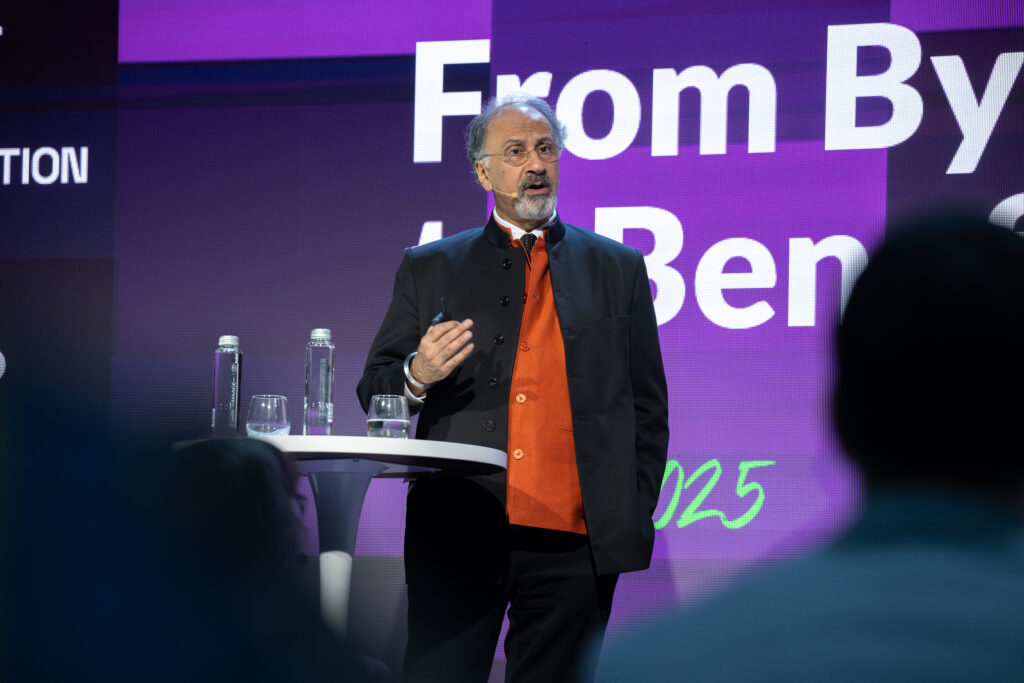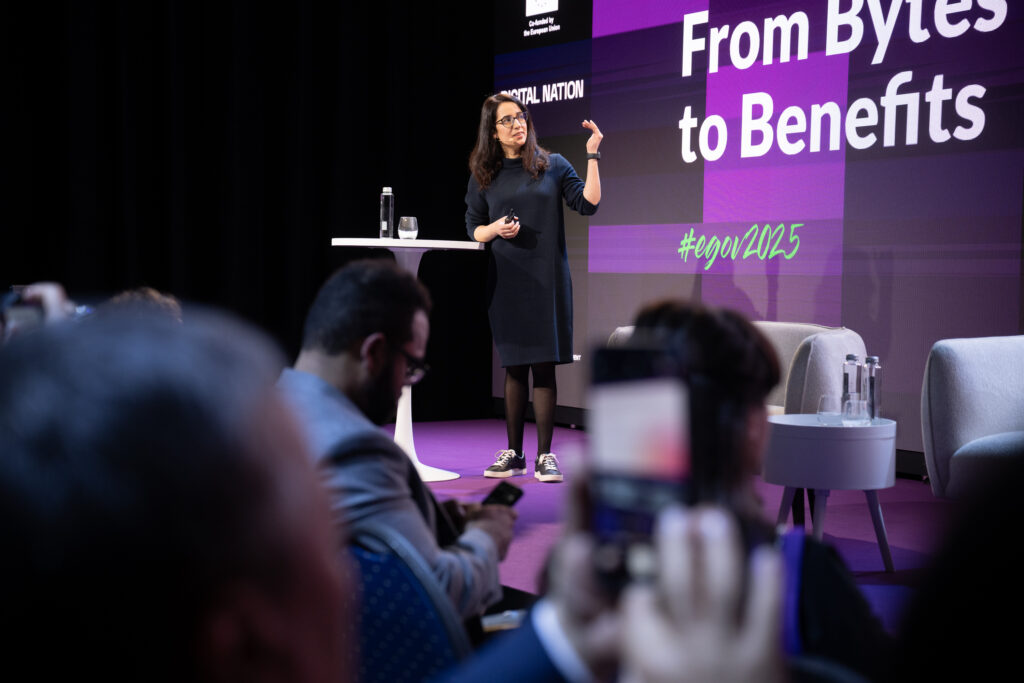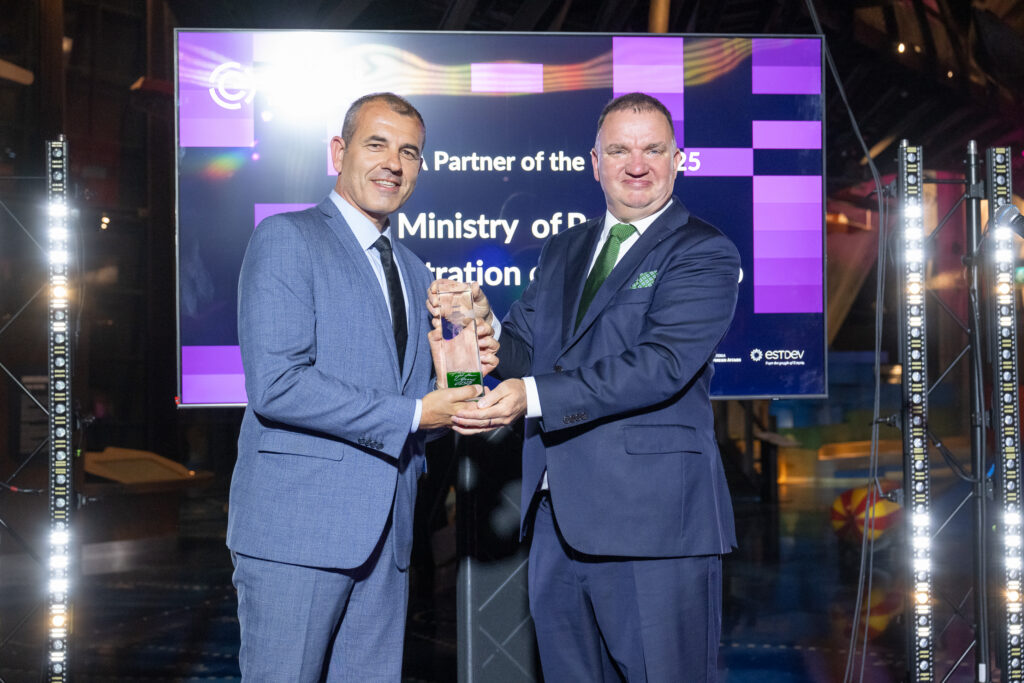By Federico Plantera
We had set out a goal for the e-Governance Conference 2025, or perhaps a research question – to consider what prosperity means in a digital age, and how close we really are to achieving it. And between slides, panels, and the classic taste of Tallinn’s spring, we’ve found some answers. Many, more than we’d have ever thought.
With over 650 participants from 85 countries, and 100 speakers on 4 stages, this year’s e-Governance Conference created a space for sharing as much as for commitment: to ensure that digital transformation translates into prosperity, from Bytes to Benefits. The energy, the density of dialogue, the quality of encounters – this year’s gathering reaffirmed why convening in person matters, and what fuels the buzz whenever we meet.
By asking how to make digital count, we pose an honest challenge to governments and experts alike. Digital tools are everywhere, but are they delivering value where it’s needed most? Are they solving the right problems? And who is left behind when they don’t?
This call reverberated across the halls of our Noblessner venue in Tallinn, grounded in a central argument: digitalisation must be reimagined not only as an engine of productivity, but as a platform for resilience, inclusion, and renewal.
Prosperity, in this context, cannot be reduced to metrics. It must be measured in trust, in wellbeing, and in people’s ability to live meaningful lives through systems that serve them.

By Federico Plantera
We had set out a goal for the e-Governance Conference 2025, or perhaps a research question – to consider what prosperity means in a digital age, and how close we really are to achieving it. And between slides, panels, and the classic taste of Tallinn’s spring, we’ve found some answers. Many, more than we’d have ever thought.
With over 650 participants from 85 countries, and 100 speakers on 4 stages, this year’s e-Governance Conference created a space for sharing as much as for commitment: to ensure that digital transformation translates into prosperity, from Bytes to Benefits. The energy, the density of dialogue, the quality of encounters – this year’s gathering reaffirmed why convening in person matters, and what fuels the buzz whenever we meet.
By asking how to make digital count, we pose an honest challenge to governments and experts alike. Digital tools are everywhere, but are they delivering value where it’s needed most? Are they solving the right problems? And who is left behind when they don’t?
This call reverberated across the halls of our Noblessner venue in Tallinn, grounded in a central argument: digitalisation must be reimagined not only as an engine of productivity, but as a platform for resilience, inclusion, and renewal.
Prosperity, in this context, cannot be reduced to metrics. It must be measured in trust, in wellbeing, and in people’s ability to live meaningful lives through systems that serve them.

One of the strongest threads running through the conference was the call to redefine prosperity. Beyond GDP or infrastructure coverage, what does it mean for a digital society to thrive? It means enabling public value – health, learning, care, trust – and not just economic growth. It means ensuring that digital supports the economy and wellbeing in tangible and intangible ways.
Speakers like Indermit Gill of the World Bank warned that while digitalisation can drive economic activity, it often falls short in addressing inequality. “Digitalisation has contributed to growth, but not always to inclusion. We need to ask who benefits, and how broadly.” He called for institutions to focus on effective public policy frameworks that can harness the full potential of technology, without deepening social divides. Across people, as across countries.
Others, like Federico Menna, encouraged us to shift the focus from fast adoption to fair outcomes. “Innovation is not a race,” he said. “It’s a responsibility.” Statements that struck a chord, in a year where digital strategies are increasingly expected to make explicit their impact. Participants returned again and again to the need for values-based digital governance, and the need for states to articulate a clear vision of what they want technology to achieve.
Matthew Blakemore, too, offered a reminder that artificial intelligence – perhaps the most powerful digital tool in use today – must be governed in ways that reflect societal priorities. “The rules we write today for AI will shape how society understands agency, responsibility, and fairness tomorrow,” he noted. Rather than chase headlines, the challenge is to anchor AI deployment in practices that foster public trust and institutional accountability.

So, what does it take for digital solutions to have real impact? Many panellists argued it takes more than good design. It takes vision, a deliberate framing of what outcomes matter. The idea that data is an asset only works when it is turned into actionable insights – and when these insights translate into better decisions, better services, and better lives.
On that basis, digital transformation strategies are poised to succeed when they take a systemic view. And if prosperity is the destination, then – on the technology side – interoperability is part of the digital architecture that gets us there. Digitalisation matters, but only when the outcomes do.
Like in Ukraine, where purposefully led digitalisation serves the people and contributes to the resilience of the country. From the Trembita data exchange platform and the Diia mobile application, to new tools enabling communication with soldiers and reservists during wartime. Their experience shows how innovation can thrive, and not just survive, even amid conflict.
Making digital count means also recognising the value of both tangible and intangible assets, from infrastructure to social trust. Trust, in particular, emerged as a recurring theme to remind us that it is not a soft value, but a hard requirement. Or as Taimar Peterkop put it – trust is the centre of gravity in democracy, and a precondition for innovation and crisis response. Without it, platforms fail, services underperform, and participation fades.
From Brazil to the Western Balkans, examples showed how trust is built through transparency, inclusion, and responsiveness. In Estonia’s own experience, for instance, the national Biobank has become a leading case of how trust can fuel participation. Citizens share sensitive data not out of obligation, but because the systems are clear, secure, and built for mutual benefit.

Speaking of the Biobank brings out how technological capacity seems to mean little, without social relevance. As Dr. Lili Milani explained, digitising health is not just a technical achievement, but one for the public good. “It’s about meeting people where they are, showing them what’s in it for them, in medical research as in daily life.”
Such a shift from delivering services to co-creating them was present throughout the conference. More governments are now involving citizens and service professionals in the design of digital public services. This trend marks a fundamental turn: digital tools are no longer built just for people, but increasingly with them.
Gabriel Souza, Vice-Governor of Rio Grande do Sul in Brazil, offered a vivid account of this in practice. His region, severely affected by climate-related floods, turned to digital platforms to maintain government operations, but also to deliver timely support to communities. “Technology became a way to protect people, not just processes,” he said. And an experience of emergency, in this way, became a case in how digitalisation can reinforce resilience in the face of crisis.
The same spirit informed reflections from Eeva Hellström on the value of intangible assets. Knowledge, trust, collaboration – these are now among the most critical drivers of national wellbeing. Yet because they are hard to measure, they are often underfunded or misunderstood. This calls for new frameworks to value what does not show up on a balance sheet, but underpins our collective capacity to act.

Cybersecurity and digital safety, too, were never discussed in isolation this year. Instead, they were treated as part of broader questions of governance and public integrity. Montenegro’s Dušan Polović, picking up the award of eGA’s Partner of the Year 2025, explained how the country responded to a major cyberattack not with panic, but with institution-building. “And so we turned problems into an advantage.”
That response required legal reforms, training programmes, a mindset shift – all elements that go beyond mere technical upgrades. In fact, an increasing number of digital resilience initiatives are now placing greater emphasis on human capacity, governance coordination, and institutional development, rather than solely on technological procurement.
Digital systems must work reliably, equitably, and transparently. That means placing governance at the heart of every digital initiative. More than once, participants returned to the insight that resilience is not a fixed trait, but a learned one. It is built through practice, through iteration, and through systems that are adaptable enough to remain stable even when circumstances change. This, too, is what public institutions must learn to train for.

The closing reflections from eGA’s own Annela Kiirats and Hannes Astok captured well the mood. This year’s conference was more than a meeting point. It was a mirror, a map, and a springboard. A mirror for assessing where we stand. A map for imagining what’s possible. A springboard for action.
Contacts and concepts sure were all there, but participants left with much more. We sensed a renewed energy to act in networks, back home, or in coalitions. The exchanges that began here are already continuing across borders and institutions. That is the power of proximity, building motivation and a sense of common direction.
Digital transformation will not succeed through code alone. It requires care, foresight, and courage. And above all, it requires a willingness to listen – to people, to data, and to each other.
The question remains: how do we make digital count? This year’s e-Governance Conference brought us closer to some answers. And just as importantly, it reminded us that asking the right questions is something we do best together.
© 2025 e-Governance Academy. All rights reserved